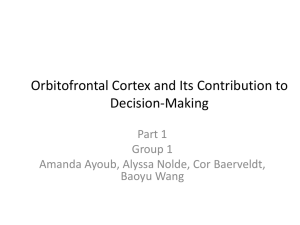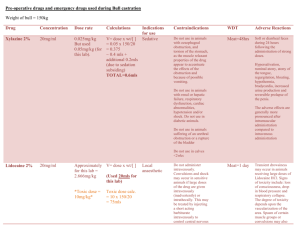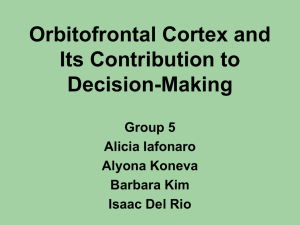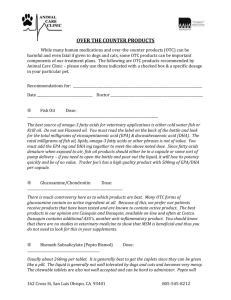Supplemental material Study population and oral challenges
advertisement
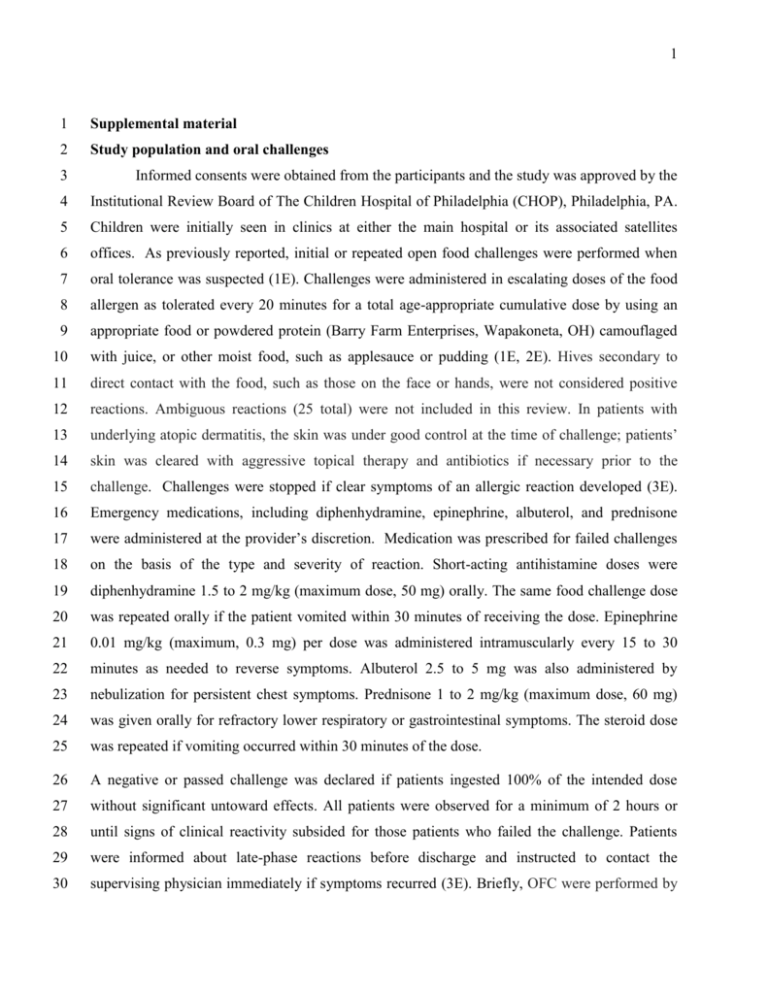
1 1 Supplemental material 2 Study population and oral challenges 3 Informed consents were obtained from the participants and the study was approved by the 4 Institutional Review Board of The Children Hospital of Philadelphia (CHOP), Philadelphia, PA. 5 Children were initially seen in clinics at either the main hospital or its associated satellites 6 offices. As previously reported, initial or repeated open food challenges were performed when 7 oral tolerance was suspected (1E). Challenges were administered in escalating doses of the food 8 allergen as tolerated every 20 minutes for a total age-appropriate cumulative dose by using an 9 appropriate food or powdered protein (Barry Farm Enterprises, Wapakoneta, OH) camouflaged 10 with juice, or other moist food, such as applesauce or pudding (1E, 2E). Hives secondary to 11 direct contact with the food, such as those on the face or hands, were not considered positive 12 reactions. Ambiguous reactions (25 total) were not included in this review. In patients with 13 underlying atopic dermatitis, the skin was under good control at the time of challenge; patients’ 14 skin was cleared with aggressive topical therapy and antibiotics if necessary prior to the 15 challenge. Challenges were stopped if clear symptoms of an allergic reaction developed (3E). 16 Emergency medications, including diphenhydramine, epinephrine, albuterol, and prednisone 17 were administered at the provider’s discretion. Medication was prescribed for failed challenges 18 on the basis of the type and severity of reaction. Short-acting antihistamine doses were 19 diphenhydramine 1.5 to 2 mg/kg (maximum dose, 50 mg) orally. The same food challenge dose 20 was repeated orally if the patient vomited within 30 minutes of receiving the dose. Epinephrine 21 0.01 mg/kg (maximum, 0.3 mg) per dose was administered intramuscularly every 15 to 30 22 minutes as needed to reverse symptoms. Albuterol 2.5 to 5 mg was also administered by 23 nebulization for persistent chest symptoms. Prednisone 1 to 2 mg/kg (maximum dose, 60 mg) 24 was given orally for refractory lower respiratory or gastrointestinal symptoms. The steroid dose 25 was repeated if vomiting occurred within 30 minutes of the dose. 26 A negative or passed challenge was declared if patients ingested 100% of the intended dose 27 without significant untoward effects. All patients were observed for a minimum of 2 hours or 28 until signs of clinical reactivity subsided for those patients who failed the challenge. Patients 29 were informed about late-phase reactions before discharge and instructed to contact the 30 supervising physician immediately if symptoms recurred (3E). Briefly, OFC were performed by 2 31 starting with a dose of 0.1 mL, followed by 0.5, 1, 2.5, 5, 10, 30, and 60 mL, 120 ml, and 240 ml 32 for liquid foods (milk). For solid foods (peanut, egg powder, milk powder, wheat and soy), the 33 challenge doses administered were 125 mg, 250 mg, 500 mg, 1 gm, 2 gm, 4 gm, 8 gm, and ad lib 34 (minimum of 8 gm). In selected cases a lower starting dose (20-60 mg) was chosen for very high 35 risk kids. Each dose was administered with an interval of 15 to 20 minutes until ad lib doses 36 were reached or the patient experienced a reaction within 2 hours of the last dose. Challenges 37 were stopped for gastrointestinal reactions, respiratory symptoms, non-contact cutaneous 38 reactions or multi-system reactions (3E) 39 40 Skin Testing 41 Reactions of wheal and flare were recorded after 20 minutes by measuring the maximal 42 longitudinal diameter of the wheal and the diameter orthogonal to it. Mean wheal diameters were 43 calculated as (a + b)/2. A wheal of 3 mm greater than the negative control, accompanied by a 44 flare, was considered positive. The positive control was 10 mg/mL of histamine dihydrochloride. 45 Food specific IgE levels and SPTs were done within 6 to 12 month of OFCs. 46 47 48 Statistical methods The children were categorized (positive or negative) on the basis positive OFC (any reaction), 49 OFC that resulted in anaphylaxis (Anaphylaxis), OFC that resulted in anaphylaxis after low 50 dose ingestion (Anaphylaxis <1g), OFC that resulted in anaphylaxis requiring epinephrine 51 i.m. administration (Anaphylaxis with epi), and OFC that resulted in anaphylaxis requiring 52 epinephrine i.m. administration after low dose ingestion(Anaphylaxis with epi<1g) 53 54 55 Collection of patient data was in compliance with the Institutional Review Board of The Children’s Hospital of Philadelphia. Characteristic Age (mean ± SD) Sex (female/male) Wheal mm (mean ± SD) Flare (mean ± SD) Serum IgE (KUI/ml) Prior Ingestion Prior Reaction Prior Reaction not skin Asthma History Eczema History Time of Prior Exposure ≥1 year OFC starting dose <100mg OFC positive OFC positive for allergen <1g Multisystemic reaction Multisystemic reaction<1g Epinephrine Epinephrine<1g 56 TABLE 1E— Demographic of the study population Wheat (93) Milk(290) Egg(409) Peanut(282) Soy (114) 3 3.6 ± 2.4 4.4± 2.5 4.7± 2.5 6.1 ± 2.6 3.7 ± 2.7 24 / 69 84/206 122/286 88/194 36 /78 5.1 ± 2.6 6.5± 3.9 5.7± 3.3 6.3± 4.2 3.8 ± 2.4 12.1 ± 15.8 17.1± 8.8 16.6± 7.9 17.3± 10.0 10.1 ± 6.9 19.9 ± 22.8 7.1± 14.7 4.8± 12.3 6.9± 18.8 14.6 ± 24.1 57 50 42 262 248 153 296 247 203 174 163 125 68 56 46 36 47 34 142 146 200 232 224 208 165 106 146 42 47 38 4 5 2 1 0 39 22 144 36 189 82 130 69 26 7 28 101 119 95 15 17 23 56 56 3 17 36 42 49 8 13 7 17 28 1 4 57 58 59 Table 2E: Wheat sIgE and SPT to Wheat in relation to OFC outcome Food challenge Food challenge Multisystemic Multisystemic to wheat to wheat reaction(28) reaction <1g negative (54) positive (39) (17) Wheat 0 0 0 0 sIgE<0.35 Wheat 1 0 (0%) 0 0 sIgE<0.350.70 Wheat sIgE 5 1 (16%) 0 0 0.71-3.50 Wheat sIgE 9 4 (30%) 1 1 3.51-17.5 Wheat sIgE 10 3 (23%) 1 1 17.6-50 Wheat sIgE 4 2 (33%) 1 0 51-100 Skin Prick 11 6 (35%) 0 0 test wheal 0-2 mm Skin Prick 29 19 (39%) 12 11 test wheal 3-5 mm Skin Prick 7 8 (53%) 4 2 test wheal 6-8 mm Skin Prick 4 4 (50%) 1 0 test wheal ≥9 mm Age 3.7±2.8 3.3±1.7 3.5±1.7 2.8±1.2 (Mean±SD) Prior reaction 20 22 14 8 not skin 5 60 61 62 Table 3E: Characteristics of children undergoing open oral food challenge (OFC) to wheat vs those undergoing OFC to other foods Type of Children Age (mean ± SE) Sex (female) (5) Wheal mm (mean ± SE) Flare mm (mean ± SE) sIgE (KUI/L) (mean ± SE) Prior Ingestion Prior Reaction Prior Reaction not skin Asthma History Eczema History Time of Prior Exposure ≥1 year 63 64 65 66 67 68 69 70 71 72 73 74 Mutlisystemic reaction<1g Wheat Other p (17) (138) 2.8 ± 5.1± <1X10-3 0.29 0.20 2 43 0.09 (11%) (31%) 4.5 ± 8.5 ± <1X10-4 0.51 0.32 11.9± 21.8 ± <1X10-4 1.15 0.7 $23± 18 $$13.1 ns ± 2.2 10 96 ns (59%) (70%) 10 95 ns (59%) (69%) 8 76 ns (47%) (55%) 10 85 ns (59%) (61%) 10 71 ns (59%) (52%) 8 84 ns (47%) (61%) Epinephrine<1g Wheat Other (13) (53) 2.9 ± 5.5 ± 0.4 0.3 1 17 (8%) (32%) 4.6 ± 9.4 ± 0.4 0.6 12.5±1 24.4 ± .7 1.2 41±n/a 17.8 ± 5.1 8 34 (62%) (63%) 8 34 (62%) (64%) 6 31 (46%) (58%) 8 30 (62%) (56%) 8 28 (62%) (52%) 7 34 (54%) (64%) p <1X10-3 0.2 <1X10-3 <1X10-4 ns ns ns ns ns ns ns References E1. Nowak-Wegrzyn, A., Assa'ad, A.H., Bahna, S.L., Bock, S.A., Sicherer, S.H., and Teuber, S.S. 2009. Work Group report: oral food challenge testing. The Journal of allergy and clinical immunology 123:S365-383. E2. Perry, T.T., Matsui, E.C., Conover-Walker, M.K., and Wood, R.A. 2004. Risk of oral food challenges. J Allergy Clin Immunol 114:1164-1168. E3. Spergel, J.M., Beausoleil, J.L., Fiedler, J.M., Ginsberg, J., Wagner, K., and Pawlowski, N.A. 2004. Correlation of initial food reactions to observed reactions on challenges. Ann Allergy Asthma Immunol 92:217-224. 6 75 76 77 78


